AG TIRE TALK KEY TAKEAWAYS
MAXAM, “Tire deflection is the amount of “bulge” the tire lowers under load as the weight or torque is applied to the tire by the equipment axle.”
PRECISION INFLATION, “What is the best or optimum deflection? There are at least 2- one for ROAD and one for FIELD.”
MICHELIN, “Proper sidewall deflection of a tire allows it to achieve optimum performance by maximizing footprint.”
CONTINENTAL, “The higher the load and the lower the inflation pressure, the bigger the resulting contact patch area…”
ALLIANCE, “When a tire is experiencing proper deflection, the tire’s sidewall is flexing (or bulging) the way it was designed to, its contact patch with the ground is optimum, and you’re reducing soil compaction and promoting even tire wear.”
BKT, “Increased Flexion (IF) and Very High Flexion (VF) tires available now in the marketplace and uses deflection for both better traction and flotation.”
CEAT, “The deflection of the sidewall acts as a bit of a shock absorber and improves ride quality. The more sidewall deflection the more the tire can flex to absorb impacts from bumps, lumps and obstacles during operation.”
TRELLEBORG, “From the farmer’s perspective, how can he be certain in getting the largest footprint possible without the risk of damaging the tire? He needs to follow the tire data book recommendations and adjust the air pressure accordingly.”
TITAN, “At the end of the day, lower inflation and higher deflection is here and staying up on these technologies are key for anyone’s operation moving into the future.”
Precision Inflation, LLC
Ken Brodbeck, VP of Technology
Tire Deflection Matters!
What is tire deflection? There are two types:
1. Vertical Deflection: Occurs as the tire is loaded vertically.
2. Bulge Deflection: As the tire load is increased, the tire sidewall bulges outward.
People look at bulge to try and determine if the tire is over or under inflated. Good luck, I have been in the tire business for 38 years, and unless I know the Load per Tire, Tire Type (Standard, IF or VF, Singles, Duals or Triples), Tractor or Harvester and speed of the machine, I can only guess at the proper tire pressure.
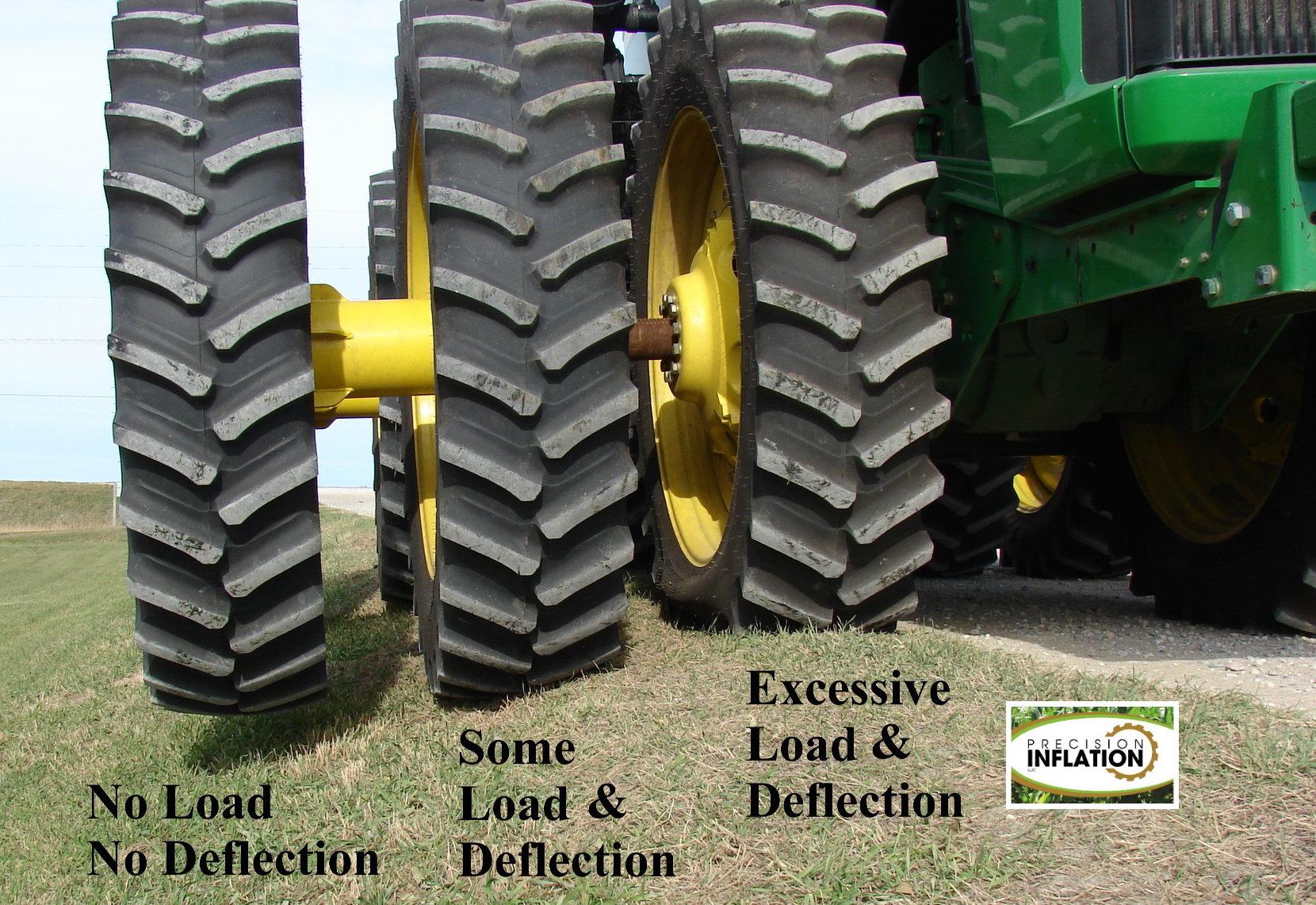
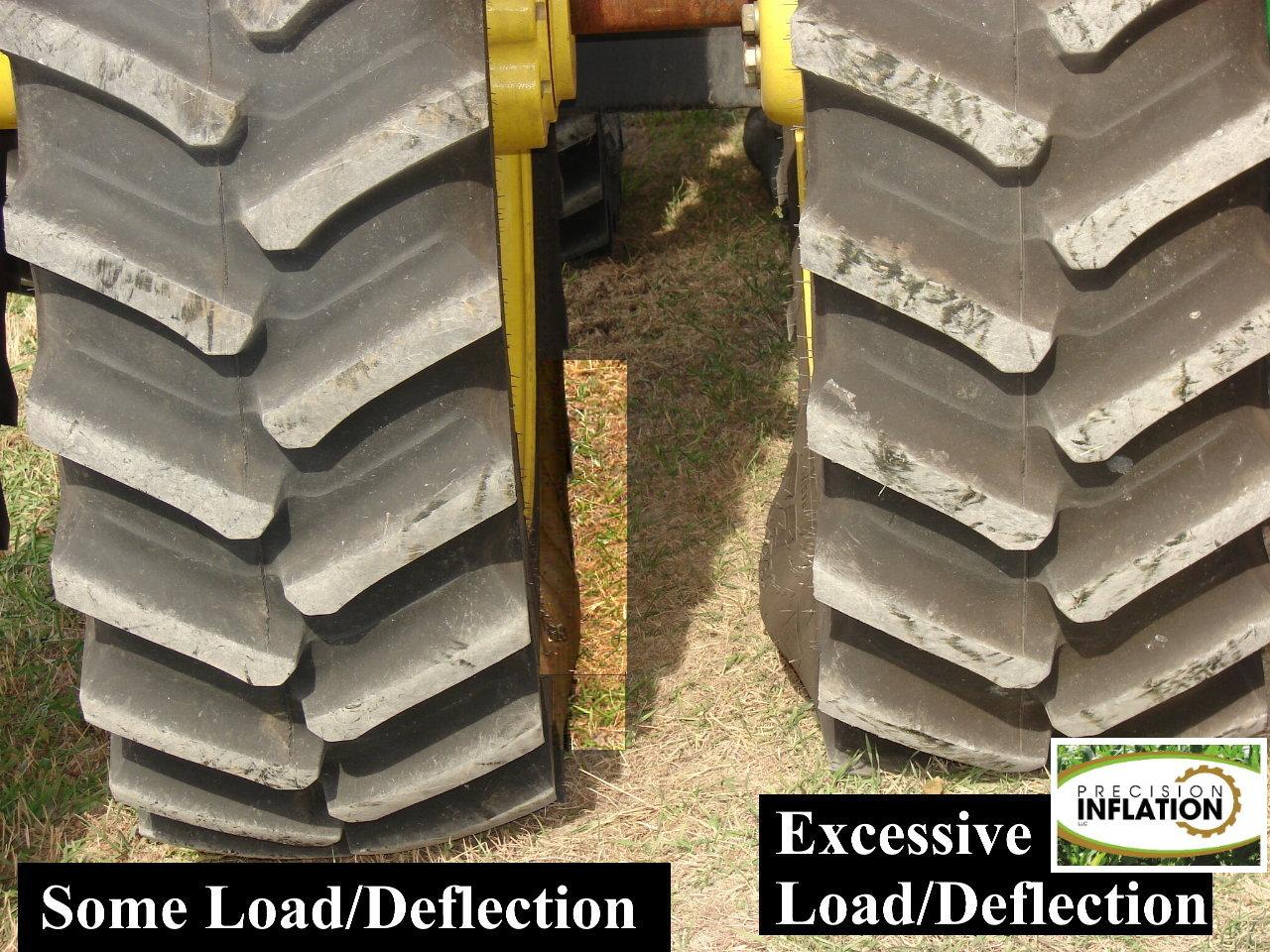 What does tire deflection affect? Almost everything.
What does tire deflection affect? Almost everything.
Over Deflection = Under-Inflation
1. Shortens tire life / durability
2. Creates excessive heat
3. Can flex out the tire sidewall
4. Create fast and / or irregular wear
5. Poor lateral stability, squishy steering response
Not Enough Deflection = Over Inflation
1. Shorten tire life from potential impact breaks of tire body
2. Create irregular wear
3. Harsh stiff ride in both field and transport
4. Excessive soil compaction from high pressures
5. Poor traction due to short / small footprint causing excessive slippage
6. Rutting in soft fields
7. Good fuel economy on the road, but poor fuel economy in the field
What is the best or optimum deflection? There are at least 2- one for ROAD and one for FIELD.
- TRANSPORT: Are you transporting between fields at 30 mph with a heavy front fold planter?
- FIELD: Or pulling the same planter in the field at 5 to 9 mph?
- Ideally, we adjust/optimize the tire pressure
- TRANSPORT = HIGHER PSI = LESS DEFLECTION.
- FIELD = LOWER PSI = HIGHER DEFLECTION.
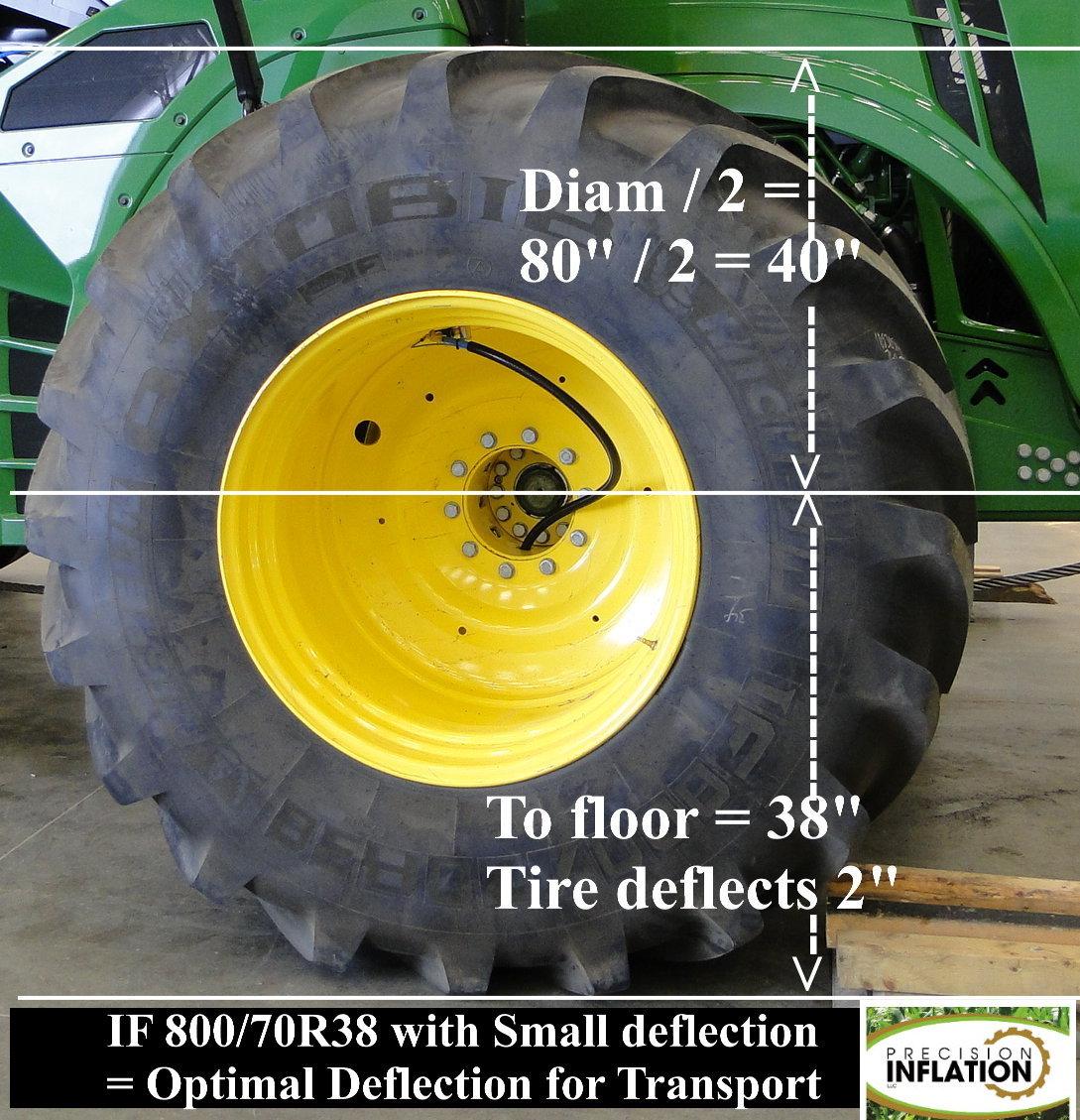
LOW DEFLECTION = OPTIMUM FOR TRANSPORT
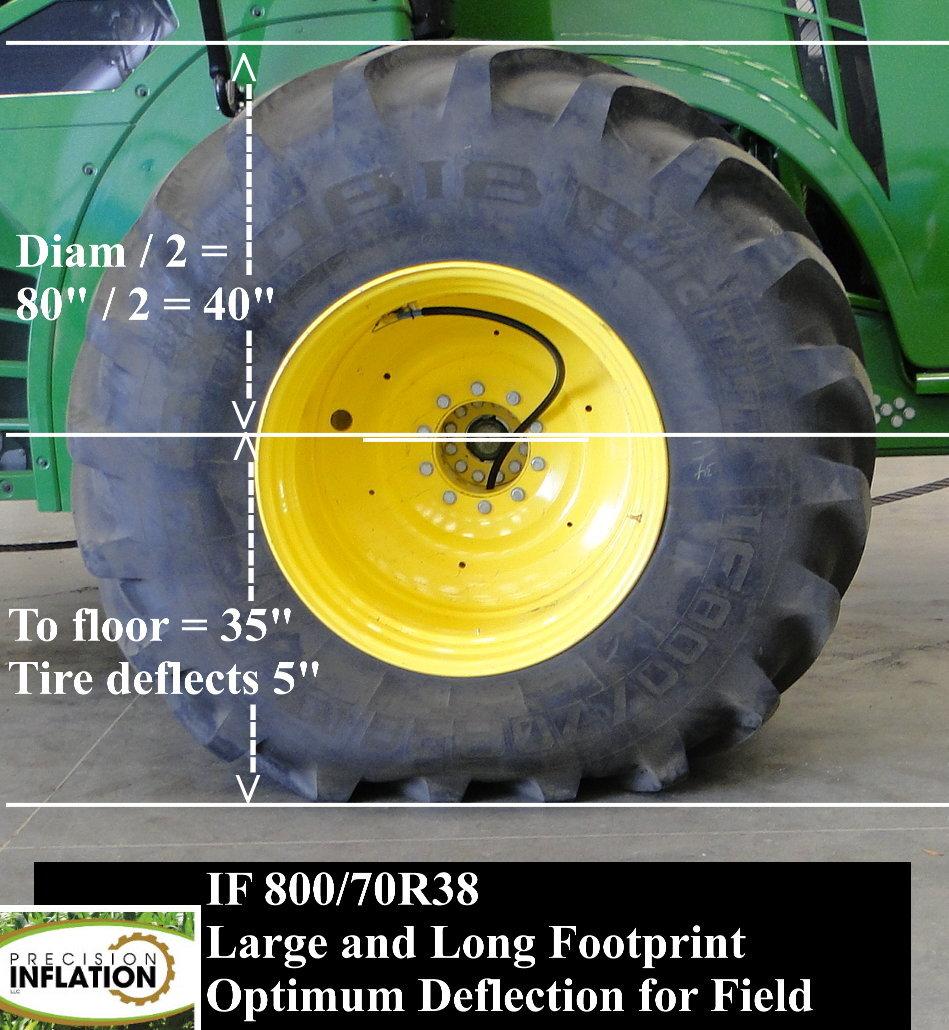
HIGH DEFLECTION = OPTIMUM FOR FIELD
Bottom line. To set your tractor tire to the optimum deflection or psi, you need:
1. Tire Size and Tire Designation: Standard, IF or VF
2. Single, Dual or Triple configuration
3. Axle Load
4. Tire companies pressure calculator usually found on their website will provide the correct psi.
- If you do not have a Central Tire Inflation System, you must select the pressure for the toughest service condition. This is usually the higher transport pressure.
- If you do have a Central Tire Inflation System, you can optimize tire deflection/inflation pressure for BOTH field and road.
Michelin Ag
David Graden: Operational Market Manager – Agriculture
Deflection Defined
How many of you have heard the comment, “Michelin Tires have soft sidewalls?” I can’t count how many times I have heard this while being a Michelin AG field sales rep. My response usually was, “Yes; and it’s by design, this the Michelin bulge!” “Michelin has purposely engineered a large bulge or to use the technical term deflection to enhance the performance of the tire.”
Proper Deflection = Maximum Footprint
Proper sidewall deflection of a tire allows it to achieve optimum performance by maximizing footprint. Traction and flotation are two of the greatest benefits, with rider comfort and increased carrying capacity being an additional benefit.
IF / VF Maximizes Deflection
Michelin recognized then need to maximize deflection in the late 1990’s and early 2000’s. In response, we invented Michelin Ultraflex Tires (2004), also known as IF (increased flexion) and VF (very increased flexion) technology.
The basic engineering behind an IF/VF tire changes the point of deflection in the sidewall and, therefore, creates an even larger footprint. This technology is considered a standard, today.
As an added bonu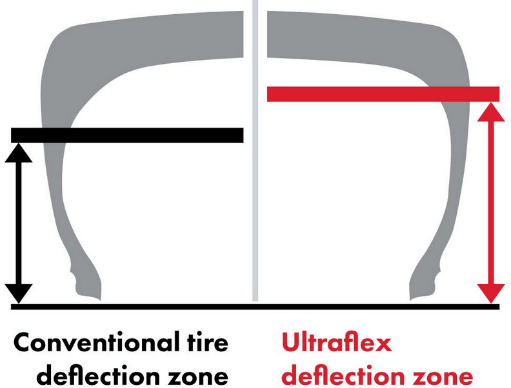 s, by changing the point of deflection and the contact patch on the ground, the carrying capacity of that tire has increased substantially. An IF tire will carry 20% more load or 20% less air pressure than a standard tire. A VF tire was designed to carry up to 40% more load or 40% less air pressure than a standard tire. The results are overall better efficiency, improved yields of up to and beyond 4% due to low soil compaction, and rider comfort.
s, by changing the point of deflection and the contact patch on the ground, the carrying capacity of that tire has increased substantially. An IF tire will carry 20% more load or 20% less air pressure than a standard tire. A VF tire was designed to carry up to 40% more load or 40% less air pressure than a standard tire. The results are overall better efficiency, improved yields of up to and beyond 4% due to low soil compaction, and rider comfort.
Air Pressure Critical for Max Deflection
To maximize the deflection and its benefits, a grower must set and maintain the manufacturer’s recommended air pressures for a given load. To be clear, this is not the air pressure stamped on the sidewall of a tire. Instead, it is the exact air pressure for a specific load and speed.
When air pressure is precisely set, the footprint of a tire is at its maximum, providing more lugs on the ground/greater surface area, better traction, fewer lbs/sq in and, therefore, better flotation.
First, check with your Ag tire dealer and/or tire manufacturer for the recommended air pressure specific to your machine and application. If you currently own Michelin Ag tires, contact your local Michelin Ag sales rep and he will be more than willing to stop by with a set of scales to weigh your machine(s) and set air pressures for you, free of charge.
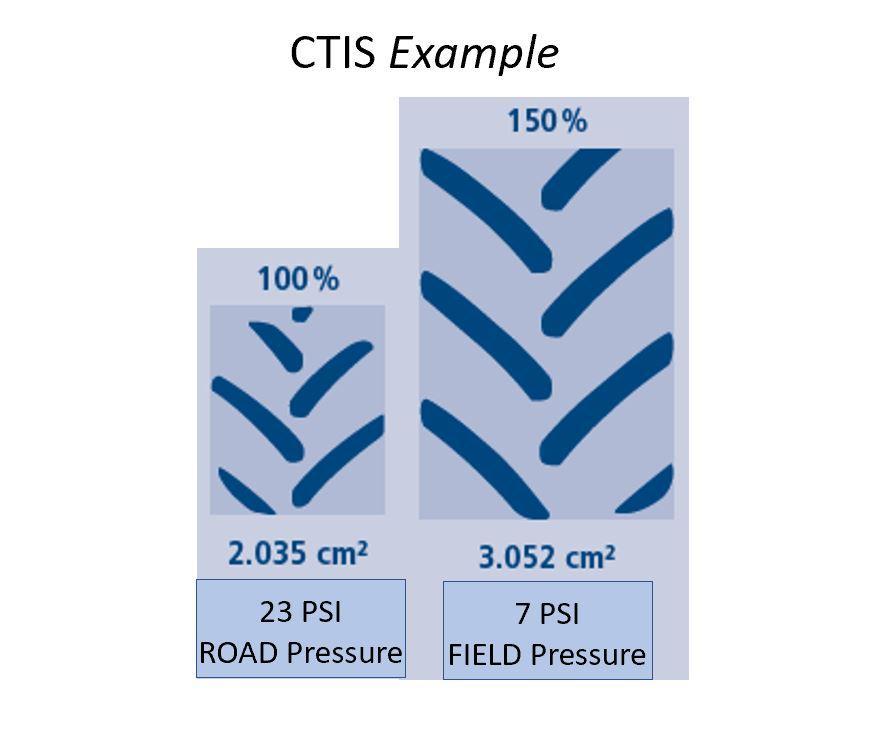 Without CTIS (Central Tire Inflation System), the recommended air pressure should carry the greatest load at the highest speed.
Without CTIS (Central Tire Inflation System), the recommended air pressure should carry the greatest load at the highest speed.
With CTIS, you can have the best of both worlds. Once your precise air pressures are determined for both field and road operation, you would input these air pressures into your CTIS and change pressures with the push of a button, while on the move! See figure left for the dramatic difference in footprint.
Still think reducing air pressure is no big deal?
Look at the image below comparing a Standard vs VF tires with 40% less air pressure:
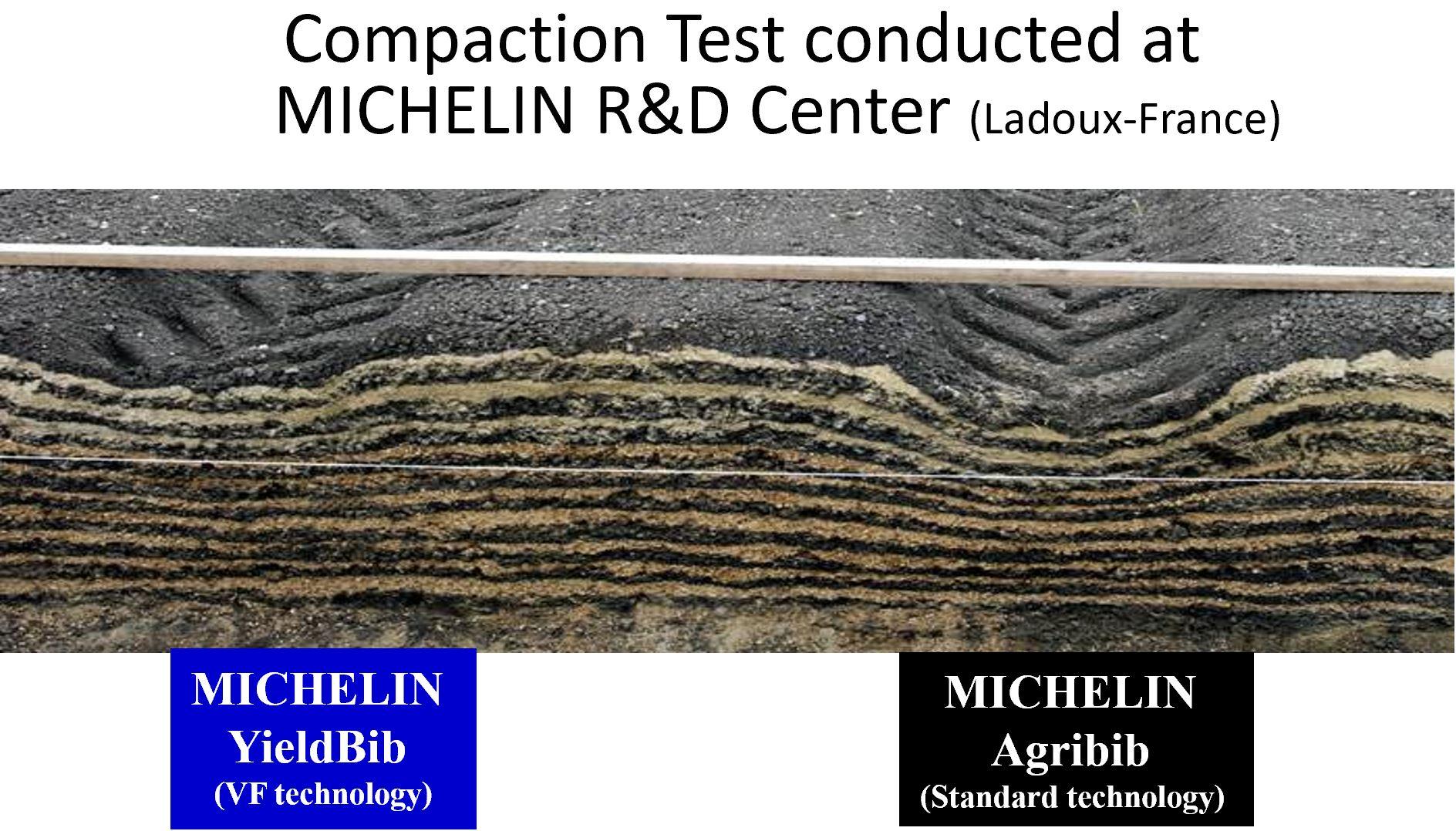
SUMMARY
In short, the overall result of proper sidewall deflection is footprint size. This leads to maximum traction, flotation, reduced soil compaction and increased carrying capacity. Translated, this is how you can achieve overall operational efficiency and add more money to your bottom line.
Continental Agriculture North America
Harm-Hendrik Lange: Customer Solutions Engineer for Continental Commercial Specialty Tires (CST)
To really understand deflection, we start with the example of a solid steel ring touching the hard ground. The contact area is only a line with the length identical to the width of the ring. Compared to that, the contact patch of a round tire is not only a line, but an area. This requires that the ideal round shape of the tire flattens in the area of the patch.
While the contact patch of a bias tire has a more elliptical shape in most cases, due to several overlapping layers, for radial type tires they are more rectangular. Why? Radial agriculture tires normally have a belt inside, beneath the tread, that works like a rubber track. Between this belt or track, the radial cords in the carcass rubber are very flexible in a sideways direction, but very strong in a forward pulling direction.
In a tire not making contact with the ground, the inflation pressure inside the tire pulls the carcass and belt to the outside and the belt reaches a perfect round shape. But if you put the tire on the ground, the load on the tire pushes the tire down to the ground. So in the contact patch area, inflation air pressure inside the tire and resistance from the ground collide.
Deflection means that the carcass supports the belt in changing the round shape in the contact area towards a flat shape. The higher the load and the lower the inflation pressure, the bigger the resulting contact patch area, creating a need for more deflection work by the carcass.
What interactions come with the effect of deflection?
- Low inflation pressure means less ground contact pressure, but requires higher deflection rates and big footprints.
- Those big footprints mean more lugs on the ground which results in better maximum traction for most soil conditions.
- Deforming the tire requires less energy compared to deforming soft soil, so flexibility of the tire is a big benefit for less fuel consumption, as long as the tire can hold the stress.
- With the belt behaving like a rubber track, the footprint mostly expands in length and less so in width as the inflation pressure is lowered or the load is increased.
- The higher the sidewall/aspect ratio, the more deflection work can be realized by the sidewall, so 85% aspect ratio can realize more footprint length than the same tire diameter and width with 65% ratio.
- In theory, a very thin and flexible carcass would be optimum for flotation, because it would consume almost no energy to deform/deflect while the tire is in rotation. But on the other hand, the carcass needs to be strong and resistant against inner and outer forces, which requires a certain thickness of material.
Finally, there are also some negative effects from high deflection:
- Deformation/deflection of the tire always requires a certain amount of energy consumption that mainly disappears as heat or, in suboptimal cases, heat build-up in the tire.
- Too strong deformation/deflection can exceed the potential of the tire and damage it. Too much deflection would cause a situation where the casing ply will fatigue after several repetitive load cycles.
- High deflection often comes with less ability to transfer lateral forces, meaning tires with lower air pressure are spongier and will start floating, which is not optimal for fast road transport or inclines.
Maxam Tire International
Greg W. Gilland: Business Development & Ag Segment Manager
All agricultural tires either radial constructed or bias / conventional constructed are designed by size or footprint to fulfill following specific functions:
- Carry the Load
- Transmit the torque (or driving power)
- Resist the lateral forces
- Allow the chosen equipment to fulfill its purpose whether in a powered or towed function
By design, radial tire construction accounts for 20% of the carcass load or pressure on the soil, while the compressed air in the tire chamber accounts for 80% of the carrying capacity. Radial tires therefore always rely on the compressed air to carry the given load. How do we know that the air in the tires are carrying the load? By the shape of its sidewall deflection or “tire bulge” under a given load.
What is Tire Deflection?
Tire deflection is the amount of “bulge” the tire lowers under load as the weight or torque is applied to the tire by the equipment axle. The deflection is the calculated difference in height between an “unloaded” tire section height and the “under-load” tire section height normally measured from tread face / shoulder to the wheel flange. The deflection amount or percentage is the difference in the two heights.

The “optimal” tire deflection in an agricultural tire ensures that as the tire compresses or deflects under the given load, the tire footprint extends to ensure that the maximum coverage is derived from the tread face delivering both the traction or flotation necessary for the equipment to work.
In simple terms, if the tires are under light load or in an “unladen” condition the footprint becomes smaller as the sidewall deflection is minimal. As the weight or load increases on the tire and the deflection increase the tire footprint becomes longer along the tread face contacting the soil.
The tire deflection created by managing the correct air pressure for a given load or speed will adjust the tire footprint length or size increasing both the tractive power (traction) or flotation (ground pressure) ensuring the tires can deliver the optimal performance. In some instance tires may appear to be under-inflated, when in fact they are “deflecting” at the sidewall to ensure the tread face is providing the correct gross flat plate delivering every ounce of performance the tires were designed to convey.
A grower can maximize his tire deflection by having a clear understanding of the weight and speed he or she will be applying on his tires for any given load. Adjusting the air pressure to ensure his tire deflection and resulting footprint is optimized to his working conditions will allow him to achieve:
- Traction (reduced fuel cost)
- Flotation (reduced compaction = greater yield)
- Faster through the field (labor cost)
- Improved tire life (tire value & wear life)
MAXAM agricultural tires are designed to deliver an optimized footprint ensuring the best possible traction and flotation for the grower’s powered and towed vehicle needs.
Alliance Tire Americas
Nick Phillippi: National Product Manager
Tire deflection, or the difference in radius between a loaded and unloaded tire, is caused by the flexing of the sidewall under load. Tire deflection is important in a number of ways. When a tire is experiencing proper deflection, the tire’s sidewall is flexing (or bulging) the way it was designed to, its contact patch with the ground is optimum, and you’re reducing soil compaction and promoting even tire wear.
Engineers design and manufacturers build tires to maintain a specific range of deflection to optimize the tires’ capabilities and service life. That’s why it is so important to match load and inflation pressure. Proper inflation pressure—when matched to the load and speed—is what allows a tire to deflect the way it is designed to. Too much pressure reduces deflection. Too little pressure allows the sidewall to flex too much.
If it’s not flexing enough, you’ll experience a rougher ride and reduce your footprint, leading to faster wear in the center of your tread. If a tire flexes too much, the movement of the sidewall creates friction and builds up heat, a sure way to ruin a tire before its time.
That’s what makes VF—very high flexion—tires so special. Their sidewalls are designed for extra flexion, which puts more lugs on the ground for better traction, better flotation, and better wear without increasing the risk of overheating from excessive flexing.
You don’t want to maximize flexion, you really want to optimize it. The key there is to check your manufacturer’s inflation table for the proper pressure for the load and speed you’ll be running—and, of course, unless you have a central tire inflation system (CTIS) to adjust for speed or load differences on the go, you’ll have to work with maximum load and speed.
To confirm that you’ve got the proper amount of flexion, you can check the static load radius of a new tire (as the tread wears, this trick doesn’t work). You will see the static load radius on the inflation chart: if your tire is inflated properly and flexing appropriately, the distance from the center of the hub to the ground will be equal to the static load radius listed on the chart. Check out this video to see the process.
BKT USA, Inc.
Dave Paulk: Manager Field Technical Services
Deflection
Deflection is a tire section height decrease measured from the center of the tire rim (or center of the hub) to the surface of the ground and is due to a tire load at a certain inflation pressure. Tire deflection can be visualized as the sidewall bulge in the lower portion of the tire between the bead and the ground contact area. Simply put, deflection is a change in the tire’s radius when a load is applied.
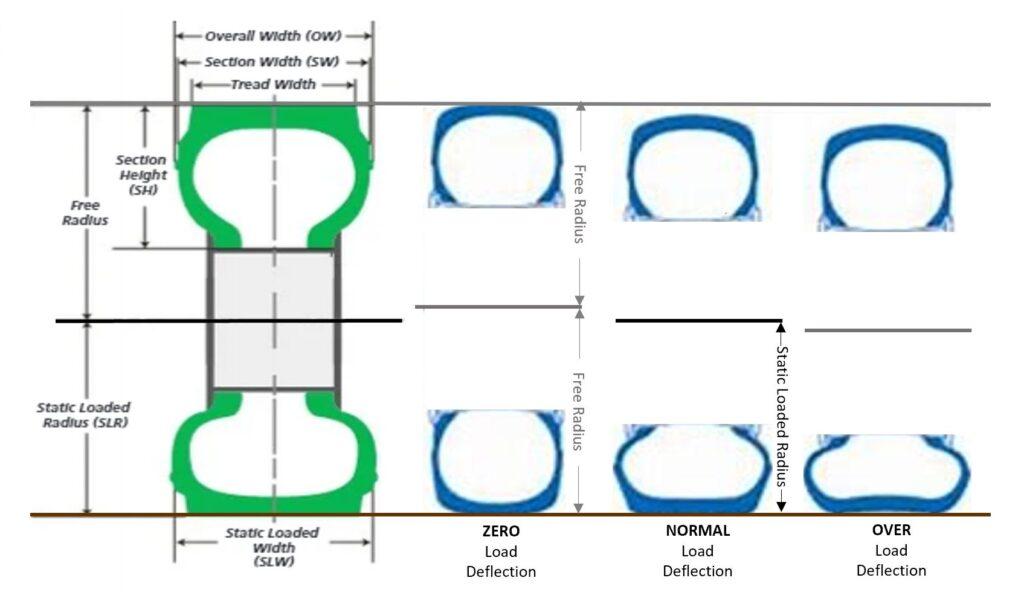
Measuring Deflection
There are different measurements that demonstrate deflection. The Static Loaded Radius (SLR) of a tire gives a good indication of deflection. SLR is the distance from the center of the tire (wheel hub) to the ground surface. SLR is measured with the tire inflated at its nominal pressure and properly mounted on the correct wheel at maximum load according to the load index chart.
The Static Loaded Width (SLW) is an indication of the tire contact patch area (footprint) under a load. SLW is the measurement of the outer distance between the tire sidewalls with the tire inflated at its nominal air pressure at maximum load.
Benefits due to Deflection
Deflection is critical in radial tire performance because it allows the tire to flex and generate a wider contact area (footprint) with the ground. The increased contact patch generates higher traction and greater flotation characteristics. The benefits of increased traction include improved time efficiency, reduced fuel costs, and optimized machinery performance. Increased flotation characteristics lead to reduced soil disturbance and decreased soil compaction which in turn increases product yield.
Agricultural radial tires specifically are designed for tire deflection within specific ranges that that can help with both traction and flotation. Radial tires in general are designed to run with a degree of deflection. In contrast, Bias Ag tires cannot be run at low air pressures.
Maximizing traction is important to be able to cover more ground and save on fuel costs by eliminating unnecessary wheel slip. This allows the tractor to pull the equipment the way it is designed.
Maximizing flotation can minimize soil compaction and save the soil and increase the crop yield. It can minimize the creation of excessive ruts in a field and help with planting and harvest when the ground is wet.
Standard agricultural tires can take advantage of running at lower air pressures and increased deflection to maximize traction and flotation. Lower air pressures minimize soil compaction (ground bearing pressure is approximately 2 pounds per square inch plus the air pressure psi) and leads to a wider tire footprint to spread the weight of the tractor or equipment over a broader area.
Increased Flexion (IF) and Very High Flexion (VF) tires available now in the marketplace and uses deflection for both better traction and flotation.
IF tires can carry 20% more weight than a standard radial tire at the same air pressure. They can carry the same weight at approximately 20% less air pressure.
VF tires carry 40% more weight at the same air pressure as a standard radial tire and can carry the same weight at approximately 40% less air pressure. This allows the deflection of the tire to spread out the footprint of the tire to distribute the weight of the equipment and enhance traction and flotation which minimizes soil compaction.
Although agricultural tires can be run at lower air pressures, they must have enough air to carry the weight of the tractor and equipment. Excessive deflection is a sign of not using enough air pressure and overloading which will lead to sidewall damage in radial tires. On the other extreme, running too much air pressure with very little deflection can lead to a greater chance of impact breaks and tire failure.
It is important to know the tractor weight and use the correct air pressures for that weight. The air pressures at field speeds are not always the same air pressures at highway speeds, so it is important to adjust the air pressure accordingly. Load and inflation charts can be found in tire manufacturers’ data books. This will minimize chances at tire failure and ensure the footprint of the tire and deflection rates are suitable.
CEAT Specialty Tires Inc.
Jim Enyart: Technical Manager
Deflection Importance:
The sidewall of an Ag tire is quite remarkable since it has to transfer the power from the bead to the tread of a drive tire while rolling, flexing and carrying the load. The Ag tires’ sidewall does several important functions that enhance the performance of the tires via deflection. The deflection of the sidewall acts as a bit of a shock absorber and improves ride quality. The more sidewall deflection the more the tire can flex to absorb impacts from bumps, lumps and obstacles during operation.
The sidewall on radial tires is designed to provide radial deflection that spreads the load over a larger area by increasing the footprint in length while maintaining uniform weight distribution. Sidewall deflection increases the length of the footprint the more the sidewall deflects which can optimize traction and flotation.
Bias tires also have sidewall deflection but that deflection is not in a radial fashion. Due to the bias construction the entire carcass is distorted as well as the weight distribution in the contact patch. The bias sidewall deflection does the same basic functions just not with the same results.
Traction Impact:
Radial sidewall deflection enables tires to increase the length of the contact area of the tread with the surface it’s traveling over. The larger the footprint the more compaction is reduced. The more deflection in the sidewall the longer the footprint will grow, to a point. The contact area will be at its’ maximum length with no air pressure in the tire. This will not work for long because air carries the load in all pneumatic tires. Flat and under inflated tires will be damaged due to over deflection of the sidewall in the shoulder and bead areas. The more under inflated a tire is for the load the quicker and more extensive the damage will be. You need to hit the “happy medium” by inflating to the most demanding application to avoid tire damage and to maximize flotation and traction by maximizing sidewall deflection.
Trelleborg Wheel Systems
Norberto Herbener: OE Applications Engineer
The main component in an agricultural tire is rubber. One of the most important features of rubber is its ability to continually bend and flex for long periods of time. A tire’s capability to “hold” a load is a combination of various rubber materials, structural materials and design, and most importantly the volume of air within the tire chamber relating to air pressure. The more air we pump into the tire, the higher the load carrying capacity of that tire (until it reaches the manufacturer safety values). Each tire size has a load carrying capacity that is defined in a specific table that has a load caring capacity for a given inflation pressure and working speed. Also, another important factor to consider is that the more air pressure you pump into the tire chamber the “harder” or stiffer the tire will get.
Modern Ag tire designs and constructions are aimed at providing the farmer with a tire that the highest traction capability, the highest flotation to lower compaction, while providing the highest operator comfort. Each tire manufacturer has their own designs, not only externally (i.e. lugs design) but also in the internal components and structure. Most Ag tires, that have an European heritage, are designed to be more flexible than the rest of the world because their tire designs rely on the tire flexing for enhanced traction, a larger footprint to spread out the load, and improved operator comfort.
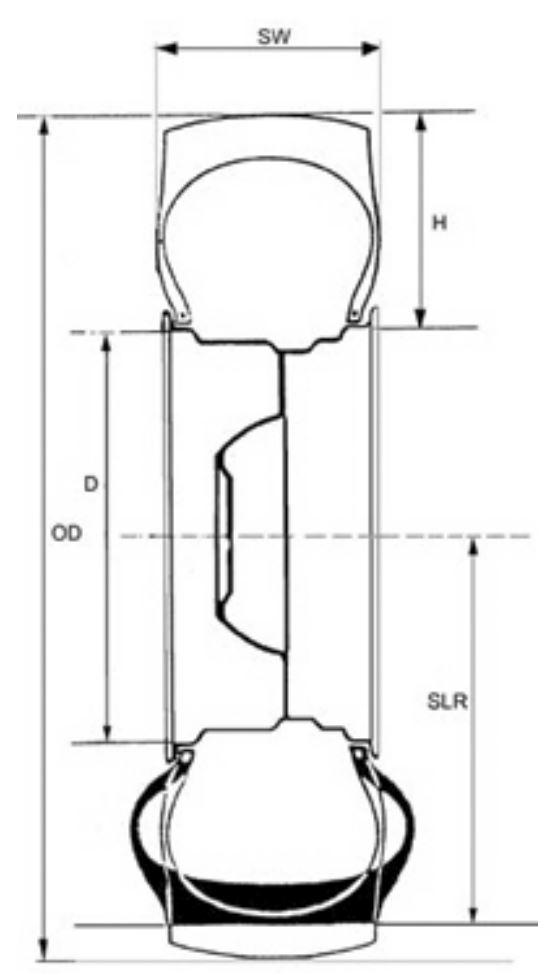
Free Radius
vs
Static Loaded Radius
This flexing, or bulging, affect is called Tire Deflection and includes a lateral, side-to-side, and a vertical radial component related to Static Loaded Radius SLR. The two deflections are measured using different static loads at different inflation pressure. This creates a graph that is used by equipment manufactures when designing new units to for load carrying capacities and to check for tire clearances with the equipment. The SLR value shown in the data books are at nominal load and nominal inflation pressure and express only the one situation.
Why is deflection important and how does it affect the tire performance? The tire plays the middle part between the transmission and the ground and is responsible to deliver the power and torque with high efficiency. It is known that the more lugs in contact with the ground, the higher the power transmission. Apart from tire lug design (shape, depth, quantity etc.) the way to have more lugs on the ground is to increase the contact area between tire and ground. It is not only the width that makes a difference, but also the length of the contact area. If you have a more flexible tire, it will be capable of increasing the footprint area compared to a rigid sidewall design tire. Also, it can increase the footprint, the traction and reduce compaction.
From the farmer’s perspective, how can he be certain in getting the largest footprint possible without the risk of damaging the tire? He needs to follow the tire data book recommendations and adjust the air pressure accordingly. Some simple steps:
- Determine what is the load each tire must hold
- Search for the correct inflation pressure based on the working speed that the load will be applied
- This will assure the tire will provide the correct deflection, maximize the footprint and transfer the transmission power to the ground with the highest efficiency.
- This correct tire air pressure will achieve the largest footprint and lowest soil compaction. Note: Studies have shown that overinflating reduces the footprint (also traction and flotation) and underinflating can damage the tire.
Titan International, Inc. (Manufacturer of Titan and Goodyear Farm Tires)
Scott Sloan: Ag Product Manager / Global LSW
Today growers are looking for more efficient ways of doing business like the uptick in precision farming practices over the last decade is an indication of them looking for ways of getting more with less. Equipment and technology has evolved to the point of enabling them to monitor the conditions of plant and soil health on a daily basis. With that in mind there has be a focus placed on soil compaction. Any piece of equipment rolling through a field affects the soil and the plants ability to reach its fullest potential. Equipment continues to grow in size and weight, minimizing the affect it has on the soil conditions has become more important than ever.
Tire technology has evolved to help minimize the impact on the soil, IF/VF technology and high flotation tires have become more and more popular. These tires carry the loads but due to the design it allows the tires to deflect more thereby allows the tires footprint to grow larger and spread the load over a larger area, which reduces ground-bearing pressures and minimizes compaction. Deflection technology in tires has been around for 15+ years. Acceptance has been slow but is making its way onto most equipment now.
Deflection when talking about tires in laymen’s terms is the amount the tire squats or the amount the sidewall bulge’s. Deflection technology like IF and VF allows the tire to run with 20% and 40% less inflation pressure than standard tires. IF and VF tires “look flat” or have much higher deflections than standard tires.
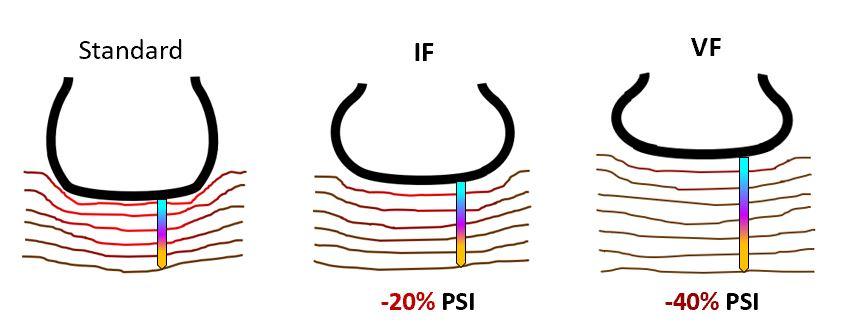
Having a larger footprint accomplishes two things not only does the larger footprint reduce soil compaction but also it also puts more lugs on the ground increasing its tractive efficiency and in turn improves fuel efficiency.
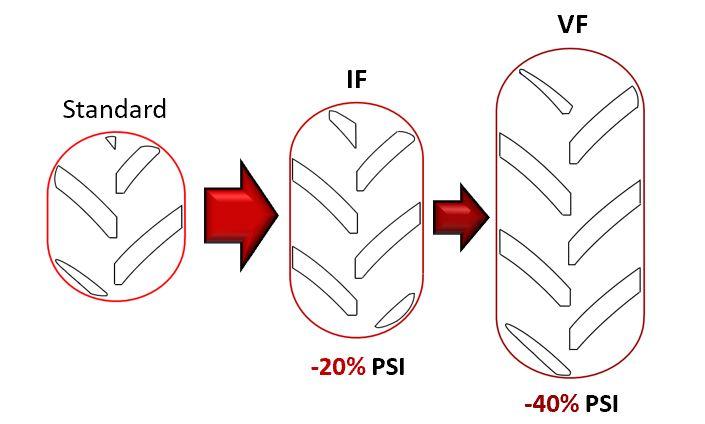
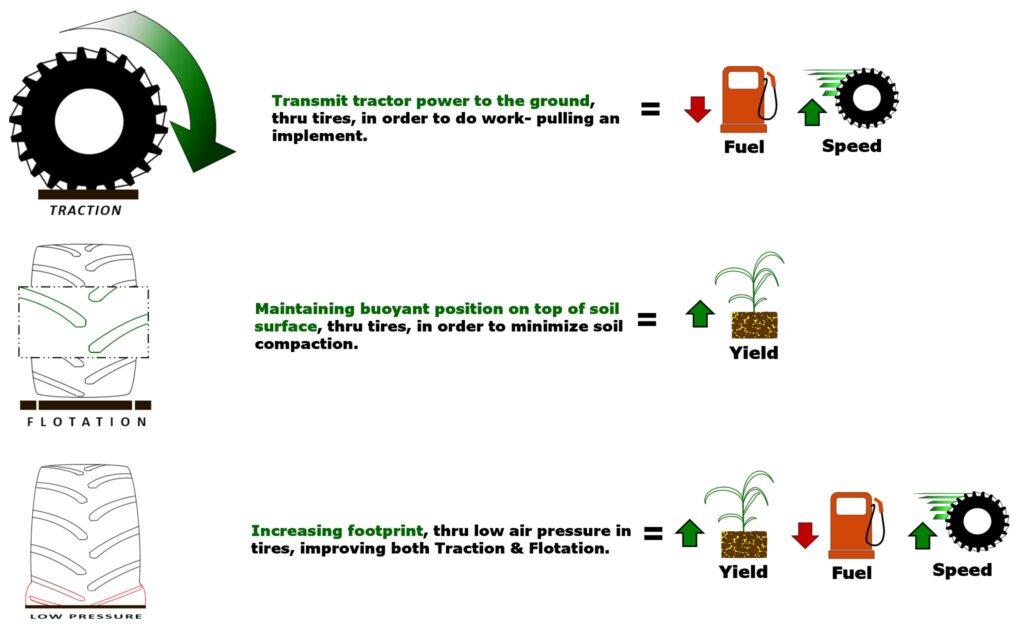
Along with IF/VF technology another trend that has be growing is converting from row crop duals to a super single fitment that we have been promoting and seeing positive results. The larger flotation tires are not only larger but are also designed using VF technology to reduce inflation pressures by 40% and makes this combination the ultimate in minimizing ground bearing pressure. By bolting this combination on to your tractor, you are increasing the total footprint of the tractor by over 30%. This allows a grower greater access into areas sooner than you could with the conventional dual combination.
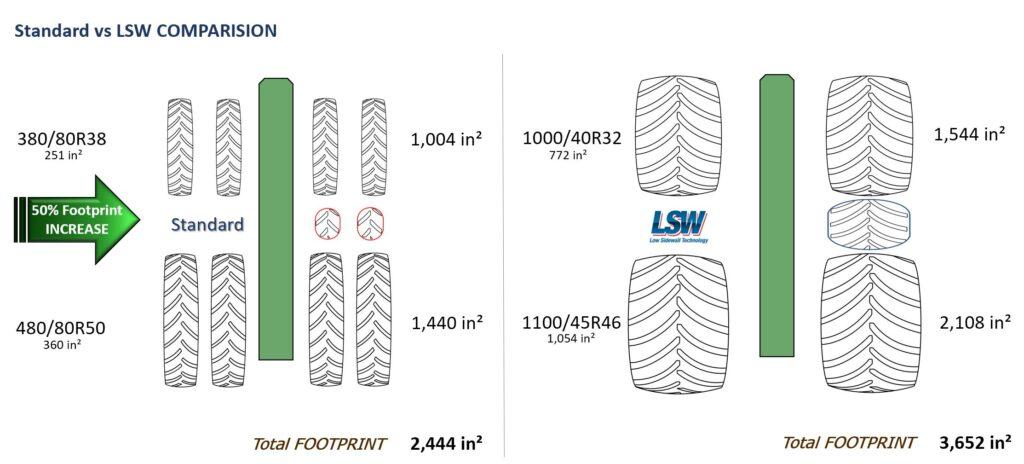
With all this being said, it does not mean a person needs to run out and purchase all new tires. With a little research, understanding what your axle loads are and by using anyone of the numerous inflation pressure calculators on line it would surprise most growers how low they can actually be running on the current tires on their equipment. This would be a no cost first step in reducing compaction with what they already have on the farm. Then next time when they are shopping for tires that would be the time to look at the next generation high deflection, high flotation tires in the market.
At the end of the day, lower inflation and higher deflection is here and staying up on these technologies are key for anyone’s operation moving into the future. Whether you choose IF/VF technology or large LSW flotation options understanding the technology is key to the success of reducing compaction and ultimately increased yields and most importantly, increased profits.
All information is provided in this blog solely to provoke thought. All deductions made from information on this site must be confirmed by Certified Ag Tire Dealer before use. Ag Tire Talk does not recommend anyone conduct tire service work with exception of Certified Ag Tire Dealer Professionals.

